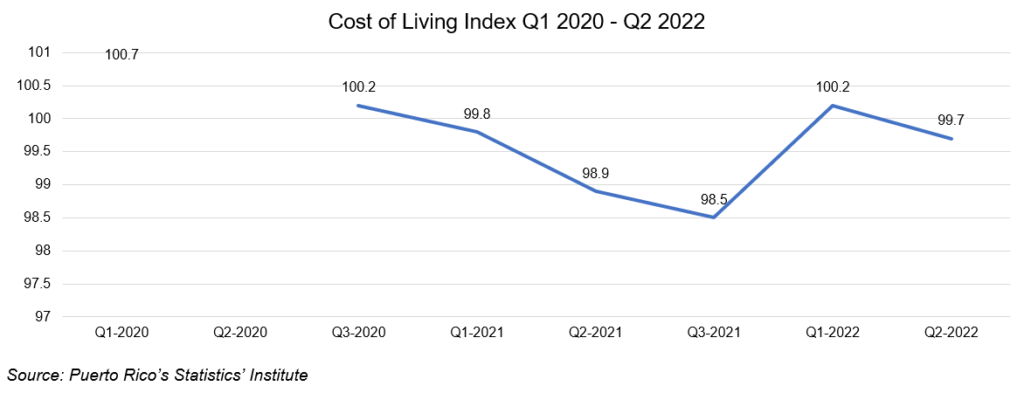| Categories | Q2-2021 | Q1 – 2022 | Q2 – 2022 | %Change Month-over-month | %Change year-over-year |
| Cost of Living Index | 98.9 | 100.2 | 99.7 | -0.50 | 0.81 |
| Cost of Living Index Grocery Items | 120.4 | 120.6 | 119.9 | -0.58 | -0.42 |
| Cost of Living Index Healthcare | 66.9 | 71.9 | 72.1 | 0.28 | 7.77 |
| Cost of Living Index Housing | 77.3 | 77 | 76.5 | -0.65 | -1.03 |
| Cost of Living Index Miscellaneous Goods and Services | 96.6 | 98.7 | 98.3 | -0.41 | 1.76 |
| Cost of Living Index Transportation | 93.4 | 88.8 | 88.3 | -0.56 | -5.46 |
| Cost of Living Index Utilities | 161.3 | 161.1 | 160.6 | -0.31 | -0.43 |
Source: Puerto Rico’s Statistics’ Institute
Puerto Rico’s Cost of Living Index [1]for 2022’s second quarter reached 99.7. This, compared to 2021’s second quarter’s Cost of Living Index, shows an 0.81% increase. However, when compared to this year’s previous quarter, the index portrays a decrease of 0.5%.
When segmented by categories, we can see how the increase viewed regarding the year-over-year change is greatly due to the increment that the Healthcare and Miscellaneous Goods and Services categories overwent, with a 7.77% and 1.76% increase respectively speaking. As for the rest of the categories, all of which saw a decrease in their respective indexes, the category for Grocery Items reached 119.9(-0.42%), Housing 76.5 (-1.03%), Transportation 98.3 (-5.46), and Utilities 160.6 (-0.43).
On another hand, the month-over-month general decrease is due to a general diminution of the index in every category, except for the Healthcare category, which incremented by (0.28%). The Grocery Items category saw a -0.58% decrease, Housing a -0.65% decrease, Miscellaneous Goods and Services a -0.41% decrease, Transportation -0.56% decrease, the Utilities’ category a -0.31% decrease.
Increments seen in the Healthcare category are worrisome when considering how recent the COVID-19 recovery is for Puerto Ricans. Moreso, a continuing increment in healthcare prices would furthermore negatively impact Puerto Rico’s healthcare system’s accessibility, given how more than 43% of its population is currently undergoing poverty levels (US Census, 2020). Taking this into consideration it is worth seeing how Hurricane Fiona’s passing in the Island will impact the general Cost of living index, especially its Healthcare category.
[1] This index is designed to compare the cost of maintaining an appropriate standard of living for professional households and moderately affluent managers in the different urban areas that participate, for which it is not comparable to the standard of living Puerto Rican average. The Puerto Rico Institute of Statistics, along with over 500 affiliated members of the Council for Community and Economic Research (C2ER), is responsible for collecting prices for 57 goods and services established by the C2ER. The data is then sent to C2ER, who calculate the average prices and index for each of the categories and for each of the geographic areas.









